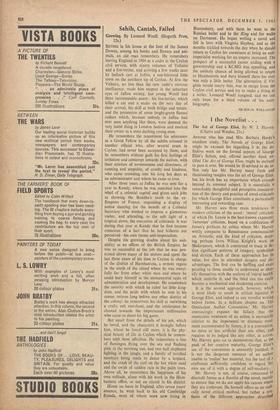I the Novelist . . .
The Art of George Eliot. By W. J. Harvey. (Chatto and Windus, 21s.) ANYONE who has read Mrs. Barbara Hardy's excellent study, The Novels of George Eliot, might be excused for regarding it as the de- finitive work on the formal aspects of George Eliot's fiction, and, offered another book en- titled The Art of George Eliot, might be inclined to pass it over. He would be ill-advised to do so. Not only has Mr. Harvey many fresh and illuminating insights into the art of George Eliot, but his book has an importance which extends beyond its nominal subject. It is essentially a remarkably thoughtful and perceptive considera- tion of the theory and practice of novel-criticism, for which George Eliot constitutes a particularlY interesting and rewarding case.
Mr. Harvey sees three main tendencies 10 modern criticism of the novel: 'moral' criticism, of which Dr. Leavis is the best-known exponent; lamesian' criticism, based on a codification Of James's prefaces by critics whom Mr. Harvey wittily compares to Renaissance commentators on Aristotle; and the kind of criticism, deriv- ing perhaps from Wilson Knight's work on Shakespeare, which is concerned to trace in fic- tion significant patterns of imagery, symbolism and diction. Each of these approaches has its value, but also its attendant dangers and dis- advantages. The first can be baffling and exas- perating to those unable to understand or iden: tify themselves with the notions of 'moral health which underlie it; and the third can too easilY become a mechanical and deadening exercise. It is the second approach, however, which is most likely to result in critical injustice 1.0 George Eliot, and indeed to any novelist writing before James. In a brilliant chapter on 'The Omniscient Author Convention,' Mr. HarveY convincingly exposes the fallacy that the omniscient treatment of an action is necessardY inferior to the impersonal or dramatic treat. ment recommended by James; it is a convention, no more or less artificial than any other, and requires to be judged like any other, in action. Mr. Harvey goes on to demonstrate that, at thp peak of her creative maturity, George Eliot! use of the convention is eminently justified; It is not the desperate resource of an author unable to 'realise' her material, but the tool of a craftsman sufficiently confident to regard her own use of it with a degree of self-mockery.
Mr. Harvey is not, of course, concerned t° discredit James as a theorist of the novel, merelY to ensure that we do not apply his canons whet! they are irrelevant. He himself offers us no radt- catty novel critical method, but rather a sY11- thesis of the different approaches described above. The difference between The Art of - George Eliot and most contemporary works of novel-criticism, however, is the difference be- tween a controlled and an uncontrolled experi- ment—the controls in this case being a respect for the total effect of a novel, an awareness of What a complex process reading a novel really IS, and the recognition that George Eliot, like any other novelist, is capable of lapses of judg- ment and expression even in her best work. Thus, for instance, before exploring a seam of water imagery in The Mill on the Floss, Mr. Harvey cautions us that 'a single striking use of one image may be of far greater importance to the total work than a dozen routine or commonplace uses of another image.'
Indeed, the only reservation one has about Mr. Harvey's book is that his scrupulosity is occasionally carried to the point of fussiness. His respect for the integrity of a work of literature occasionally leads him to imply that the only valid commentary on a novel is the novel itself. And while this is, in a sense, true, it does not get us very far. Criticism must abstract, must simplify and select, and no injury will be done to a work of art if the critic remains aware, While scrutinising any given aspect of it, of the complexity of the total experience with which he is dealing. Such an awareness is in fact pre- cisely what distinguishes Mr. Harvey's subtle and searching examinations of George Eliot's handling of time, structure, character and lan- guage; and I make the point merely out of an anxiety that so sensitive a critic should not allow himself to become inhibited by his very proper suspicion of the methods he uses. This book will be read with sustained excitement by anyone Concerned with the criticism of fiction.
DAVID LODGE







































 Previous page
Previous page